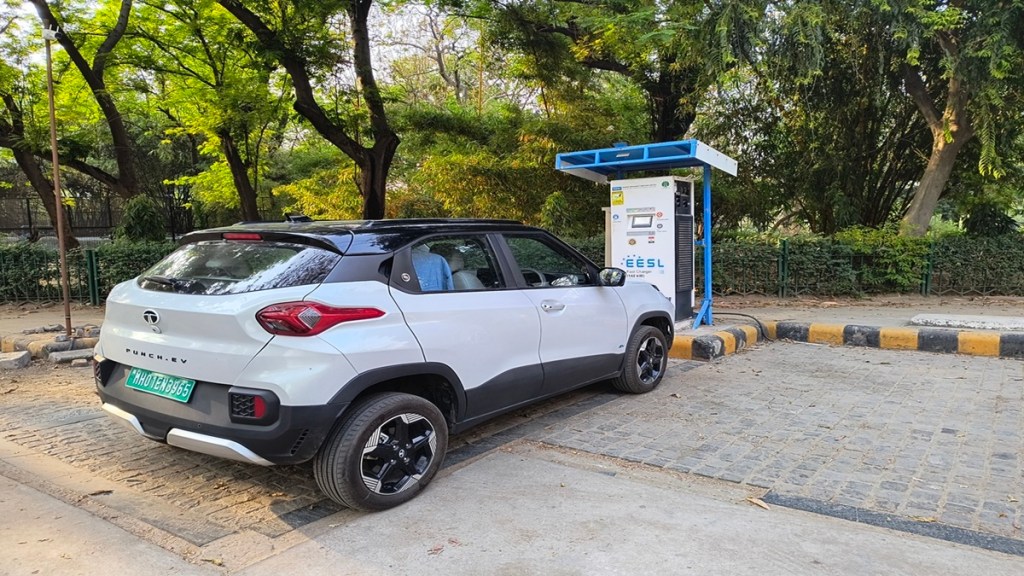With Delhi readying its most advanced EV policy, how easy is it to live with an electric car in the National Capital Region (NCR). I spent a couple of weeks with one of India’s most popular EVs, the Tata Punch EV, and found that unless you have an EV charger installed at home or place of work, living with an EV is not as easy as a petrol/diesel car.
Not yet.
The car
The Punch EV matches the Creta turbo in acceleration, and the Splendor bike in running costs. There are two variants (25-kWh battery and 265 km range), and the LR (long range) version with 35-kWh battery and 365 km range. It’s priced from Rs 9.99 lakh Rs 14.44 lakh, ex-showroom.
I tested the LR variant.
The design
It’s a small SUV – 3,857 mm long and 1,742 mm wide – but because of its long wheelbase (2,445 mm), space is good for five adults (thanks to a flat floor). It comes without a spare wheel, and that means more boot space – instead of a spare wheel, it has a puncture-repair kit.
The drive
Shift the rotary dial to ‘D’, select the Sport mode, and let the car fly. The Punch EV LR does 0-100 km/h in just 9.5 seconds – as fast as the turbocharged Hyundai Creta. There are minimal vibrations inside the cabin, and the motor produces a barely audible whining sound.
Is the range real?
No, the claimed range is 365 km, but my test car was able to do a maximum of 300 km on full charge. The real-world range is 270-300 km.
Challenges I faced
The car I drove was a media unit, given by Tata Motors to test. I don’t have a charger installed at home, nor do I live on ground floor where I can use the regular 15 Amp socket for overnight charging.
So, I had to rely on public charging and that wasn’t as easy as topping up fuel in a petrol/diesel car.
Some reflections
– A couple of Tata Power EZ Charge stations I used in Delhi didn’t charge at the claimed 30 kW per hour, but at 12-15 kW per hour (this meant double the time waiting for the car to charge).
– A Tata Power public charging point located in the basement parking of the Park Hotel in Connaught Place was occupied by a petrol/diesel car (for parking purposes). The guard tried to find the driver, but it was a hassle, so I drove out (the basement parking was too tight even for my small EV).
– Then I went to the IOCL pump Shivaji Stadium EV charging station, but some construction activity meant it was temporarily not available.
– Then I downloaded the Statiq app, which took me to the EESL fast charger (60 kW) on the Mother Teresa Cresent behind the Rashtrapati Bhavan. It had ample space, and a lot of tree shade to wait. Plugged in, however, the charger charged at half the speed (about 27 kW), which meant I had to do some ancillary spend (cup of tea, biscuits, followed by a bottle of water). It was also expensive, at Rs 22.4 per unit (the cost of charging at home ranges from Rs 6 to Rs 10, depending on electricity tariff).
Will an owner face these challenges?
No. Because Tata Motors told me that most EV owners charge at home (carmakers will instal a home charger when you buy an EV) and public chargers are used mostly for emergency charging.
If I owned this Punch EV, I wouldn’t have to rely on public chargers at all.
Why I loved it
Despite challenges, the Punch EV was dirt-cheap to drive. Even the most expensive fast charging cost me Rs 2 per km. In case I was charging at home, my running cost would be just Rs 1 per km (compare that to Rs 6-8 per km for petrol/diesel cars).
Another benefit was a very quiet cabin and zero engine vibration (because there is no engine), making commuting very comfortable.
A third benefit was instant torque – in the Sport mode, the Punch EV behaves like a sportscar.
Where to charge?
– The standard 15 Amp socket (called the power socket, on which you use your AC, refrigerator, etc) takes full night to charge the battery.
– Tata Motors provides a dedicated EV charger (installed at home/office) and it takes 6-14 hours to charge, depending on whether it’s 7.2 kW or 3.3 kW.
– AC slow (3-7 kW) and medium (11-22 kW) public chargers can charge your car by the time you finish watching a film or a long brunch.
– DC fast chargers are expensive but give a decent amount of range by the time you finish a coffee or quick meal.
– But no kind of charging is as fast as filling up petrol/diesel.
